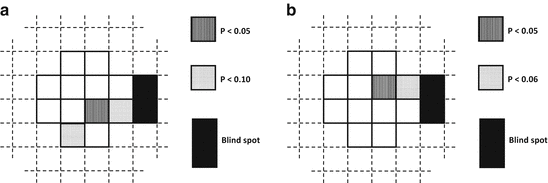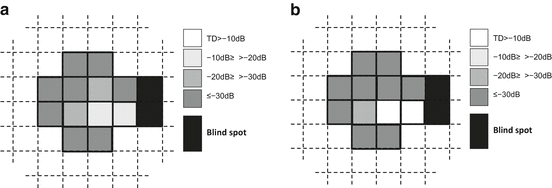(5.1)
Where TDi is the TD value at the i-th test point, A and B are regression coefficients, and C is a regression constant. The extent of age-corrected damage at a questioned i-th test point, TDi, was thought to be significantly influenced by myopic refraction when the regression coefficient, A, was significantly different from zero (P < 0.05) after correcting for the influence of overall glaucomatous damage (i.e., the stage of the disease), that is, B × MD. The background of the subjects and our results are summarized in Table 5.1 and Fig. 5.1. We obtained similar results in both types of POAG: the extent of VF damage in the lower cecocentral subfield was positively correlated with myopic power (i.e., higher myopia was associated with more VF damage), while damage in the upper paracentral subfield was negatively correlated with myopic power (i.e., higher myopia was associated with less VF damage). The influence of myopic refraction on VF is apparently different in POAG eyes than in otherwise normal highly myopic eyes, in which it has been reported that the superior temporal subfield is mainly affected [18–21]. This indicates that the interaction between co-existing myopic changes and glaucoma exacerbates damage in the area of the ONH corresponding to the lower cecocentral visual subfield. In the superior paracentral subfield, higher myopia was found to be associated with less damage. Although this finding is rather unexpected, it is possible that anatomical changes induced in and around the ONH as myopia progresses can lessen its susceptibility resistance to some of the pathogenic factors of POAG. The degree of optic disc torsion induced by myopia may be at least partly related to this characteristic pattern of VF damage in myopic POAG [32].
Table 5.1
Background data of patients with mild to moderate glaucomatous damage
POAG with elevated IOP | POAG with normal IOP | |
|---|---|---|
Number of cases (eyes) | 138 (197) | 86 (120) |
Age (years) | 49.9 ± 11.7 | 48.2 ± 9.4 |
Refraction (diopters) | −4.1 ± 3.6 | −3.8 ± 326 |
Mean deviation (dB) | −12.4 ± 9.0 | −11.8 ± 7.2 |

Fig. 5.1
(a) Correlation of total deviation values and myopic power in POAG eyes with elevated IOP and mild to moderate damage. POAG: primary open angle glaucoma, IOP: intraocular pressure. (b) Correlation of total deviation values and myopic power in POAG eyes with normal IOP and mild to moderate damage. POAG primary open angle glaucoma, IOP intraocular pressure
The influence of myopia on VF damage in POAG may be glaucoma stage-dependent, although most existing studies have included only eyes with mild to moderate glaucomatous damage, and few of the study participants listed in Table 5.1 were in the late stage of the disease (MD ≤ −15 dB). Thus, we carried out a second study including only late-stage POAG patients (MD ≤ −15 dB) [30] (Table 5.2). We found that the lower cecocentral subfield was as likely to be damaged in late-stage POAG with elevated IOP as it was in the earlier stage of the disease [30, 31] (Fig. 5.2). Interestingly, this was not the case in late-stage NTG eyes. The superior paracentral subfield was more likely to be relatively preserved in late-stage NTG eyes with higher myopic power (Fig. 5.2). This disease stage-dependent difference in the pattern of myopia-related influence on glaucomatous VF damage in POAG eyes with elevated IOP and those with normal IOP, i.e., NTG, suggests that IOP-dependent pathomechanisms may interact with myopia-induced changes in and around the ONH as glaucomatous damage progresses. The lower cecocentral subfield is usually preserved until the late stages of glaucoma [33, 34] and has the greatest functional importance in vision-related quality of life [35]. These results suggest that myopic patients with POAG and elevated IOP, especially those with high myopia, may be more likely to lose their central vision in the late stages of glaucoma (Fig. 5.3), and therefore need more careful clinical follow-up and IOP control.


Table 5.2
Background data of patients with advanced glaucomatous damage
POAG with elevated IOP | POAG with normal IOP | |
|---|---|---|
Number of cases (eyes) | 176 (176) | 137 (137) |
Age (years) | 56.9 ± 12.1 | 57.9 ± 12.3 |
Refraction (diopters) | −2.4 ± 3.6 | −2.4 ± 3.5 |
Mean deviation (dB) | −21.9 ± 4.4 | 20.7 ± 3.6 |

Fig. 5.2
(a) Test points in which total deviation values were positively correlated with myopic power in POAG eyes with elevated IOP. POAG primary open angle glaucoma, IOP intraocular pressure. (b) Test points in which total deviation values were negatively correlated with myopic power in POAG eyes with normal IOP. POAG primary open angle glaucoma, IOP intraocular pressure

Fig. 5.3
(a) Visual field simulation of highly myopic (−10.0 diopters) POAG eyes with elevated IOP and mean deviation values of −30 dB, based on the results of multiple regression analysis. (b) Visual field simulation of emmetropic POAG eyes with normal IOP and mean deviation values of −30 dB, based on the results of multiple regression analysis
In addition to the above results, we also found that a higher myopic power also had a deleterious effect on central visual acuity in POAG eyes with advanced damage. In a separate group of late-stage POAG eyes, we used a multiple linear regression analysis to study the effects of myopic power on central visual acuity (Table 5.3), with best-corrected visual acuity (log MAR) as the response variable, and age, overall VF damage (in MD), myopic power (in diopters), IOP (POAG with normal IOP vs. POAG with elevated IOP), and the more damaged hemifield (upper vs. lower hemifield) as the explanatory variables. We found that best-corrected visual acuity was associated with higher myopic power (P < 0.001) and higher IOP (POAG with elevated IOP) (P = 0.035), a finding that agreed with those we obtained for the central VF.
Table 5.3
Background data of patients in analysis of relationship between best-corrected visual acuity and myopic refraction
Number of cases (eyes) | 83 (104) |
POAG with elevated IOP | 57 (71) |
POAG with normal IOP | 26 (33) |
Age (years) | 55.6 ± 12.7 |
Refraction (diopters) | −4.0 ± 4.5 |
Mean deviation (dB) | −23.6 ± 3.0 |
Best corrected visual acuitya | 0.02 ~ 1.2 |
Our findings on increasing myopia in POAG are compatible with the structural finding that highly myopic eyes are more susceptible to papillo-macular nerve fiber layer defects [36, 37]. In addition, many previous histological studies have suggested that myopia-associated structural changes in the ONH make the optic nerve fibers more vulnerable to various insults [7–10].
5.4 Visual Field Damage Progression in Myopic Glaucoma
Since myopia is a definite risk factor for POAG [1, 2], it is easy to speculate that VF damage is more likely to progress in eyes with myopic glaucoma than in those with non-myopic glaucoma. Indeed, previous studies have observed VF damage more frequently in myopic patients with untreated ocular hypertension [38, 39], supporting the view that myopia is a risk factor for more rapid progression of the disease, and have also found that myopia is a significant risk factor for the initial development of POAG [40, 41]. Further, several studies agreed that high myopia was a risk factor for the progression of VF damage even with medical treatment [42–45]. On the other hand, as far as medically treated POAG eyes with mild to moderate myopia are concerned, there is evidence that mild to moderate myopia is not a significant risk factor for further progression of VF damage [44, 46–49]. For example, Sohn et al. carried out a retrospective observational study in which they observed the progression of VF damage over 5 or more years in 4 subgroups of NTG patients, all receiving treatment: non-myopic, mild myopic, moderate myopic, and high myopic. They found that the rate of progression was around −1.0 dB of MD change/year in all 4 subgroups, with no significant inter-group differences [49]. We also carried out a retrospective observational study, in which we analyzed, over an 8 year period, the VF test results of non-high-myopic NTG patients undergoing medical treatment. We found that the progress of VF damage was slow but statistically significant, with an average MD change/year of −0.16 dB [50]. Additionally, a subfield-based analysis of the time-course change in VF damage showed that stronger myopia was a significant positive prognostic factor for VF damage progression in the superior paracentral subfield, i.e., progression was more likely in the less myopic eyes. These findings were compatible with the results of our previous cross-sectional studies, in which we found that in POAG eyes with normal IOP, TD values in the superior paracentral subfield were negatively, significantly correlated with myopic power, and that higher myopia was associated with less damage in the superior paracentral subfield [30, 31]. Further, this result was reproduced in a prospective cohort study. We prospectively followed, for 3 years, 146 eyes of patients with POAG and normal IOP. The patients had a mean untreated IOP of 14 mmHg, mild to moderate visual field damage and mean spherical equivalent refraction of −3.5 diopters under topical nipradilol or timolol [51]. The IOP after treatment averaged 13.2 mmHg, and an analysis using the Cox proportional hazards model revealed that optic disc hemorrhage (hazard ratio [HR] 4.00, p < 0.001) and weaker myopia (per diopter, HR 1.15, p = 0.013) were significant risk factors, when progression was defined by VF damage progression and/or deterioration of disc appearance. When progression was solely defined by VF damage progression, weaker myopia was again a significant risk factor, and stronger myopia was associated with slower progression (HR 1.17, p = 0.038).
Stay updated, free articles. Join our Telegram channel

Full access? Get Clinical Tree


